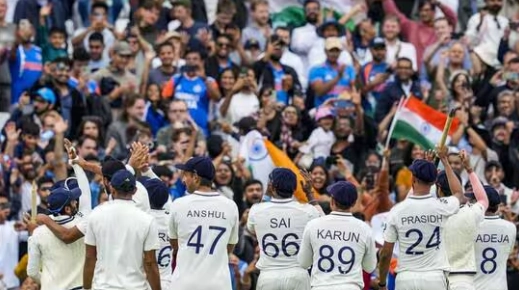 When the final day of the final Test is played to packed stands on a Monday morning, even though the match could end in an hour, you know it’s the kind of cricket the public can’t get enough of.
When the final day of the final Test is played to packed stands on a Monday morning, even though the match could end in an hour, you know it’s the kind of cricket the public can’t get enough of.
And purely in terms of excitement, the five-Test series between hosts England and India will go down in history as among the most memorable.
2025 England-India is in the league of 2020-21 Australia-India, 2005 Ashes, 2001 India-Australia. Or even the 1960-61 Australia-West Indies spectacle, at the end of which people thronged the streets of Melbourne to give the visitors, who had lost the series, a wonderful send-off.
Good teams make their sport watchable, grow their audience. This series did plenty of that. At a time when the longer format is struggling to stay relevant in the middle of a T20 revolution, the series was a great advertisement for Test cricket.
Each of the five Tests went into the fifth day, the series squared 2-2. There were no winners or losers, only entertainers.
In recent times, India has been part of some epic contests because of their fearless brand of cricket. The 2001 series win at home is a classic, difficult to improve on, but who can forget the great fightback in the Border-Gavaskar Trophy of 2020-21 after India lost a majority of first-choice players to injuries?
For England, the Ashes often takes centre-stage. This series would have rekindled memories of 2005 when Michael Vaughan’s men beat the odds to stun a Shane Warne-inspired Australia, who were the team to beat. There was also the 1981 Ashes, where England’s talismanic all-rounder Ian Botham played the starring role.
Like Australia in the 2000s, the West Indies till the 1990s were the team to be beaten. It is difficult to match what Australia and the West Indies dished out in 1960-61.
Melbourne lined up on its streets to give the West Indies a fitting send-off in appreciation of their brand of attacking cricket over five Tests. Frank Worrell’s side was paraded in open-top cars on February 17, 1961. The series had witnessed the first-ever tied Test, the first of only two instances in the longest format.
Every entertaining series leaves an impact, with the contesting teams coming to be known for their unique qualities. Clive Lloyd’s West Indies of the 1970s, the most dominating force in the history of the game, came to be identified by their feared pace battery and dynamic batting. Imran Khan’s Pakistan, which took on Viv Richards’s mighty West Indies at home in a thrilling three-Test series in 1988, had an all-round bowling attack with the leg-spin of Abdul Qadir complementing the pace of Imran and Wasim Akram. Steve Waugh’s all-conquering side of the 2000s had strength in depth.
India’s impressive phase away from home, since the combination of Virat Kohli and Ravi Shastri took over, was mainly centred around bowlers and building a fast bowling unit capable of meeting fire with fire.
Jasprit Bumrah was added to the combination of Ishant Sharma, Mohammed Shami, Bhuvneshwar Kumar and Umesh Yadav to go with the ace spin options of R Ashwin and Ravindra Jadeja.
The Anderson-Tendulkar trophy, however, will be remembered for the batting brilliance of Shubman Gill’s team.
In any era, taking on India on flat pitches is never a good idea. One has to just look at two names: Sunil Gavaskar and Sachin Tendulkar.
In the previous series in England, in 2021-22, India got rattled in the postponed fifth Test at Edgbaston when Jonny Bairstow and Joe Root stumped the bowlers with their second-innings counter-attack. But after three years, the Indian think-tank also knew what England was up to.
Coach Gautam Gambhir went to England equipped with a batting arsenal ready to take on Bazball. The result: England didn’t have the answer to India’s counter.
Captain Ben Stokes and coach Brendon McCullum wanted flat pitches to blunt the threat of Bumrah. It turned out to be an invitation to plunder runs for Gill. On featherbeds, England were stumped by the India skipper’s love for batting. On his way to 269 at Edgbaston, Gill took occupation of the crease to another level.
Until the bowler-friendly surface at the Oval for the final Test, the bat dominated the series. It meant this became the first five-Test contest in which over 7,000 runs were scored. There were 20 centuries, with India making 12. There were four Indian batters among the top six run-scorers: Gill, KL Rahul, Ravindra Jadeja and Rishabh Pant.
It had everything that only a hard-fought five-Test series played over the full 25 days can contain. It called upon cricketers to persist through injuries. Rishabh Pant batted with a broken foot at Old Trafford, Shoaib Bashir bowled England to victory at Lord’s with a broken finger, and Chris Woakes came out to bat with a dislocated left shoulder.
This series had multiple star performances, but the best came from Mohammed Siraj. The pace bowler showed the heart and spunk, playing in all the Tests and bowling more than 180 overs to become the most important bowling figures of the series. Siraj’s disarming smile endears him to fans. For a series this enthralling, it was fitting that Siraj would sign off as its face.